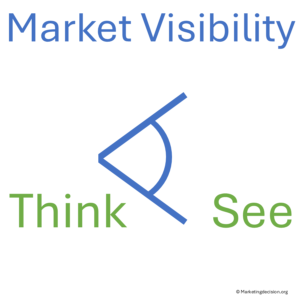
Visibility is a powerful concept when it comes to grasping market dynamics effectively.
Getting a grip on the market environment, using tools like PESTLE analysis, Porter’s Five Forces, and other analysis methods, is necessary but insufficient to address the need for dynamic and continuous scrutiny of market changes. Market visibility introduces the idea of continuously evolving comprehension, emphasizing vigilance and sustained interest in monitoring the market landscape.
An analogy is that of a car, boat, or any vehicle. The driver must constantly check the space in front of the vehicle and evaluate possible obstacles first at a far distance and then close, while managing multiple objects and constraints simultaneously.
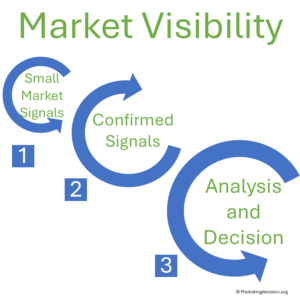
There are two separate actions: one to identify events and market signals and a second to analyze and make strategic decisions based on those events.
A company faces the same situation where the market must be constantly scrutinized and analyzed for an optimal adaptation of the course of actions. Visibility is the capacity to identify small signals when they are still weak signals and unverified, to understand and analyze those signals, and to take actions that will transform them into competitive advantages. Those signals can come from many sources – from customer conversations to competitor announcements, and even job postings that hint at new strategies. For practical examples, see this guide to business signals which highlights ways teams can track and interpret them.
Visibility provides the capacity to understand the market long before events are clearly identified.
This requires both the captors and sensors to identify those events, and the nervous system to transport and transform those events so that the company can adapt its course optimally.
There’s no evidence that market visibility happens automatically.

This is a skill that companies develop because if they all develop the capacity to bear, resist, and transform unforeseen events, they always prefer to be proactive and develop the capacity to anticipate – that is, identify threats or opportunities and take proper action – to quickly adjust course and take advantage over the competition.
In short, in a company, all individuals facing customers directly or indirectly are those captors and sensors that a company needs. The nervous system is the capacity for teams to share and escalate information efficiently. For instance, a small and tiny signal that a competitor is introducing a new product may be a faint signal that a salesperson is aware of. With the opportunity to discuss such events across a sales team, this information will most probably be shared and discussed across individuals, and possibly confirmed.
There is evidence that companies must have a positive attitude and support sales and marketing or other externally focused teams in sharing and discussing these topics. Spending time and effort in meetings on those topics is an investment more than a cost. But like any resource, always scarce, it needs to be spent wisely.
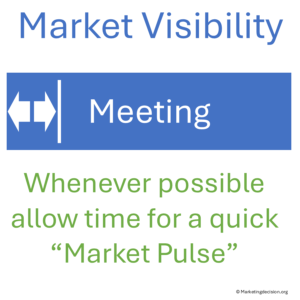
A good approach to market visibility is to start any of these recurrent sales calls – typically weekly or monthly – with a quick roundtable discussion on external events and competitive activities. Ensure that everyone gets a chance to speak up during this roundtable and take time to discuss consequences or actions as part of the meeting discussion. The initial pass should focus on gathering both small and large signals to ensure that all topics will be appropriately discussed. It needs to be time bounded so the effort can be repeated meeting after meeting.
A second approach is to allow dedicated meetings to review the market environment, share across teams on key learning points from a month or a quarter of sales and marketing activities. Such recurring meetings can be orchestrated and set in a marketing and sales agenda.
When developing operating mechanisms for increased market visibility, consider using Stakeholder Analysis to evaluate strengths and engagement in visibility efforts. In parallel, apply the RACI Matrix to clarify roles and responsibilities, ensuring that the flow of information is smooth and that teams remain confident in their approach. Together, these tools strengthen alignment, improve collaboration, and make it easier to transform signals into actionable insights.

Understanding market trends, capturing the company’s position, and comprehending competitive moves are essential. However, many roadblocks hinder the quality and efficiency of market visibility:
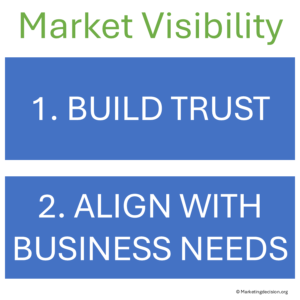
The recommended approach to overcoming these roadblocks is twofold:
The risk of those meetings dedicated to understanding the market environment is to miss their objective, which is to optimize the company course in a changing market environment. Business meetings focusing on aligning trends and events can become extremely boring when not articulated around the important question “so what?”.
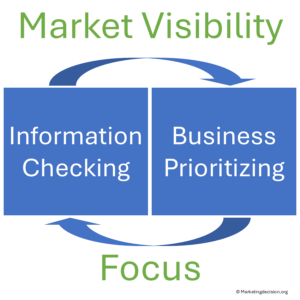
There is a need at all times to align such meetings with key business questions. Events and their impacts, and proposed actions, become entangled into business actions that drive team alignments along clear objectives.
Here are some of these questions that must be addressed consistently — some focusing more on the long term, others on the short term. By dealing with these questions, teams can be best realigned to ensure information is exchanged and utilized effectively:
Answers to these questions are often not straightforward. Engaging business teams in regular, clear discussions ensure market visibility strategies are aligned with priorities and helps review the course of their business.
See also: Decision Risks and Opportunities Matrix
Initiating these discussions is key to solidify teams around common objectives and deliver team spirit and cohesion:
Market visibility is an approach to ensure teams are constantly seeking market events, whether small or large, and aligning forces for the company to pursue the best business course.
Teams should remain focused on key business questions to ensure that the means – for identifying, analyzing, and taking actions from events – are properly aligned and efficiently support the business. Trust serves as a binding agent for efficient visibility and acts as a cohesive factor for successful teams.
Ensuring that every sales or marketing meeting begins with a roundtable review of external events – emphasizing external focus – while asking the critical “so what?” question is essential for market visibility. This practice fosters team cohesiveness and enhances a company’s performance in a changing market environment.
Developing more formal, market visibility practices such as market-focused meetings is essential. This approach will consolidate all other findings, enabling continuous adjustment of the company’s course and preparation for future marketing plans.
Market visibility is the ability of a company to continuously observe and interpret signals — particularly when they are still weak and imprecise — from the market environment (competitors, customers, and external events). This capability enables companies to adapt strategies early and turn insights into a competitive advantage.
Strong market visibility allows companies to spot early signals, anticipate threats, and identify opportunities before competitors do. It helps align sales and marketing teams, improve decision-making across functions, and support long-term business adaptation throughout the organization.
Companies can improve market visibility by organizing regular market review meetings, using tools like PESTLE analysis and Porter’s Five Forces, encouraging sales teams to share field insights, and building trust so that weak signals are openly discussed and acted upon. Reinforcing and rewarding contributions from all functions further strengthens visibility efforts.
The main challenges include the time and effort required to review potentially unreliable or unverified data, as well as the risk of missing the few valuable signals hidden within the noise. Other difficulties are misinterpreted market trends, management impatience for quick results, and lack of collaboration or trust among teams. Overcoming these barriers requires discipline, openness, and a structured approach — with patience and trust making the real long-term difference.
© marketingdecision.org
One of the most effective tools for sales teams is a well-structured agenda for regular team meetings — typically held weekly — where members can share new information gathered from customer interactions. Bringing together sales and marketing teams for these discussions allows small but valuable insights to be consolidated, revealing market trends or issues that might otherwise go unnoticed until it’s too late.
Recognizing and congratulating team members for their efforts in staying externally focused is another powerful motivator. It’s important to create an environment where individuals feel comfortable sharing information that contributes to the team’s success. Managers play a key role in creating this positive, open culture.
Start each meeting with a brief roundtable to gather market signals and identify competitive moves. If a particular topic requires more discussion than time allows, schedule a follow-up meeting to explore the potential threat or opportunity in greater detail.
The following section may include tools, some free, some with a fee to support this site development. If you consider a tool should be presented in this section and is missing, please let us know at: contact@marketingdecision.org
Informed decision-making relies on a profound understanding of the market environment, current trends, company performance, and competitive strategies.
The solution presented here is a team meeting checklist, a free tool designed to facilitate regular market review meetings. It serves to consolidate lessons learned, identify opportunities, and swiftly learn from mistakes. In essence, it helps identify actions to engage in order to leverage the situation to your advantage.
© 2025 MARKETING DECISION SOLUTIONS. All Rights Reserved.